Tall Buildings
Firmament at Toranomon Hills
OMA
Leo Villareal
BY JOSEPHINE MINUTILLO
Artist Leo Villareal has brought dancing lights to the cables of the Bay Bridge connecting San Francisco and Oakland. He’s illuminated the Thames River in London. His Multiverse transformed a tunnel connecting the East and West Buildings of the National Gallery in Washington, D.C. Smaller-scale interventions have had big impact on individual buildings. At the recently completed Lindemann Performing Arts Center at Brown University by REX, his Infinite Composition of white LED panels over structural columns injects life into the lobby (RECORD, November 2023).
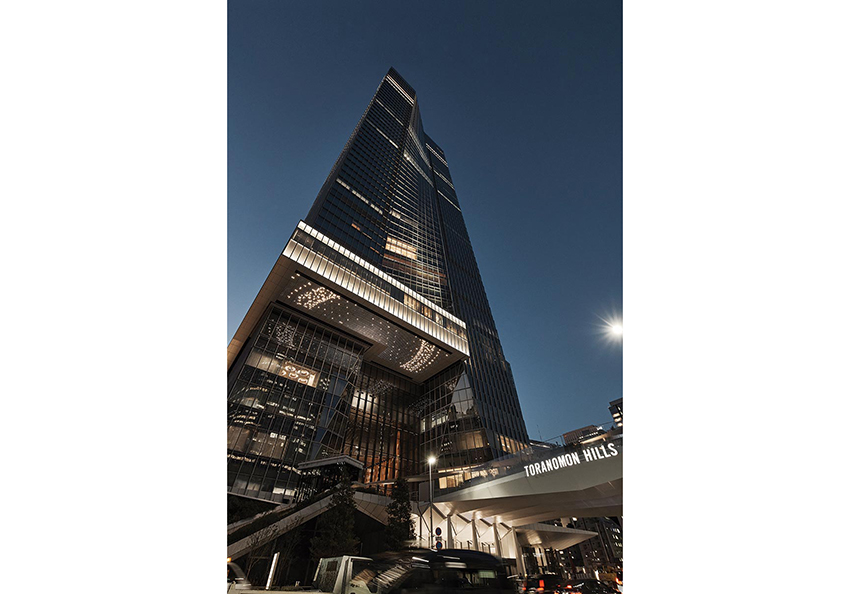
PHOTOGRAPHY: © INKI KANG
Artist Leo Villareal brings a dynamic light show to OMA’s Tokyo tower, emphasizing its role as a gateway to a new neighborhood.
His biggest impact on a building may be his latest. Firmament at OMA’s Toranomon Hills Station Tower (page 94), is an emphatic punctuation mark at the tower’s entrance. Like all of Villareal’s work, it is a site-specific piece that, in this case, underscores the building’s role as a gateway to Tokyo’s recent Toranomon Hills development at one end of the newly reconfigured Shintora-dori Avenue. By dynamically illuminating the underside of OMA’s sky bridge, 132 feet above the ground, day and night, the artwork, which, for Villareal was meant to connect to the sky and cosmos, enchants visitors to the building and its belowground metro station as well as passersby on the street. “We had a proposal to do the top of the building, which was one idea,” says Villareal. “But this building occupied a very special location, so it was intriguing to me to activate the bottom of the sky bridge.”
Inspired by artists such as Diego Rivera, Villareal likens the 126-foot-long, L-shaped panel to a mural, the kind that, like Rivera’s, adorn historic buildings. Only here, the reflection of the piece in the tower’s glass skin creates a doubling effect of the constantly moving light show.
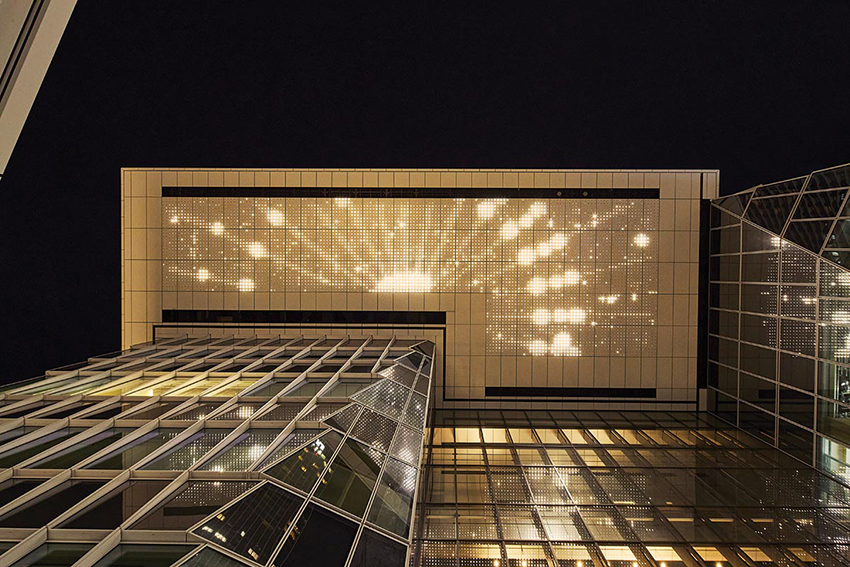
PHOTOGRAPHY: © INKI KANG
To some, the 6,000 LED nodes within Firmament may seem to react to the people walking beneath it, but the artwork does not contain sensors. “I did do some interactive pieces early on,” recalls Villareal, “but I found it difficult to create a satisfying experience like that.”
Instead, after spending several nights on-site observing the mixed-use tower, its many spaces, and how people move around it, Villareal created different visual sequences. These are displayed in a random order and for a random amount of time. Layers of sequences are dynamically combined so that observers are not seeing the same thing over and over. “It’s not a loop,” says Villareal. “I’m really shuffling the deck.”
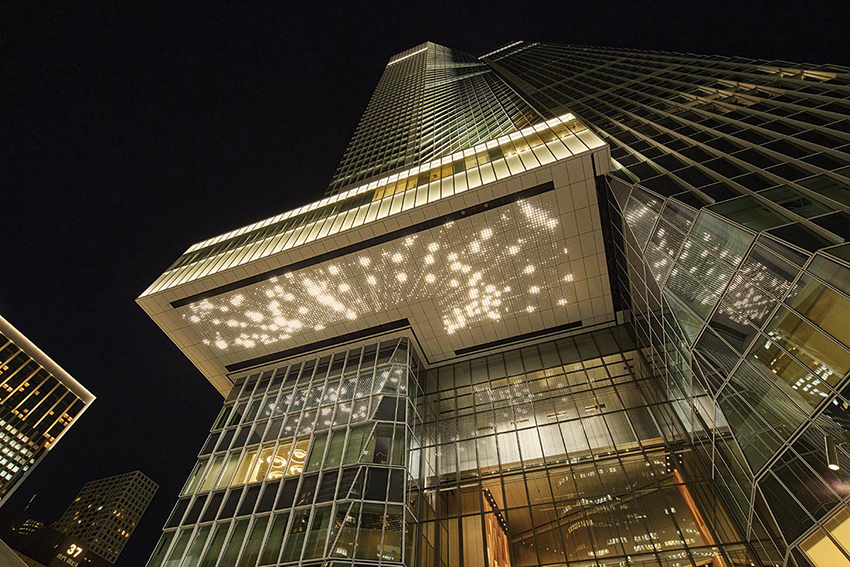
PHOTOGRAPHY: © INKI KANG
To distinguish the quality of the light in this piece from the ambient light, Villareal used a 4000 Kelvin color temperature. The resolution of the graphics is relatively low compared to some of Villareal’s other more recent work. “I like how pared down it is and how it evokes something like an early kind of video game, which probably resonates in Japan,” says the artist. Using customized tools and working with products from Color Kinetics, the artwork incorporates LED nodes, power supplies, network switches, and computers, and is meant to be a permanent fixture on the building. “We have the ability to do some debugging remotely if we need to, but fortunately we haven’t had any issues, and the software we create is very robust.”
Villareal has described his pieces as digital campfires, bringing people together to observe a phenomenon. “The public nature of the work—that it’s available and free to everyone—is very important to me.”
Mori JP Tower
Pelli Clarke & Partners
L’OBSERVATOIRE INTERNATIONAL
BY LEOPOLDO VILLARDI
A stone’s throw from Toranomon Hills Station Tower (page 100) in Minato-ku, the ward in Tokyo that plays host to a suite of international company headquarters and national embassies, the Pelli Clarke & Partners–designed Mori JP Tower elegantly ascends to new heights—literally. At 1,083 feet, the building is the tallest skyscraper in Japan (only two communications structures surpass it in height) and represents the pinnacle of a 30-year relationship between architect and client, Mori Building.
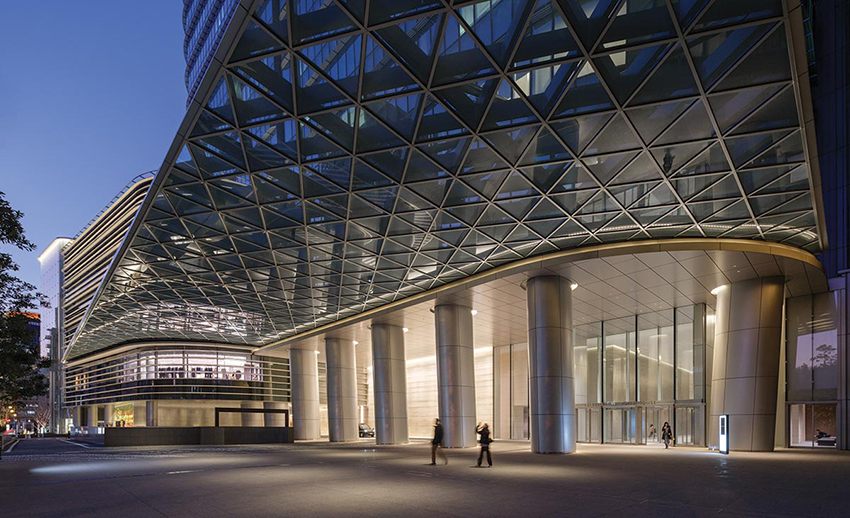
PHOTOGRAPHY: © JASON O’REAR
Four vertical channels break up the skyscraper’s volume. Downlights wash columns and walls.
Mori JP Tower forms the centerpiece of a mixed-use, three-tower urban village called Azabudai Hills, master-planned by PC&P but with smaller-scale architectural contributions by Thomas Heatherwick and Sou Fujimoto, among others.
Measuring 267 feet square at its thickest—wider than a Manhattan block—Mori JP Tower would have appeared staggeringly stout without the help of a few design moves with big impact, reinforced in the evening by L’Observatoire International’s lighting scheme. The bulky height-to-width ratio prompted the introduction of a vertical channel down the middle of each face, rendering the otherwise singular tower into a bundle of four narrower volumes. The tower softly billows, like entasis, tapering at the base and toward its petal-like crown. Rounded corners add to the visual trickery at play, as does highly transparent low-iron glass, which gives the tower a silvery cast akin to a Mikimoto pearl, says Fred Clarke, partner at PC&P. “It has a commanding but still quiet presence.”
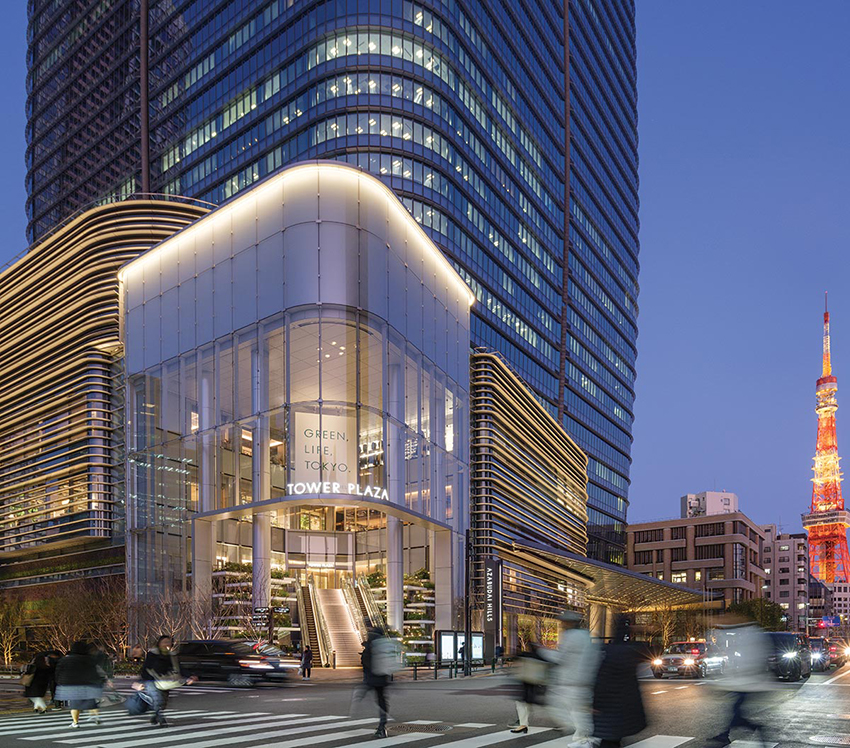
PHOTOGRAPHY: © JASON O’REAR
But, as L’Observatoire founder Hervé Descottes notes, “our cities live at night.” Tokyo is incredibly bright, he adds, while also pointing out that very few towers have lit crowns. “It’s important that they connect with people and serve as locators.”
Although 48 floors of Mori JP Tower were planned as leasable office space, the top 10 levels house Aman Resorts–branded residences. To ensure that the apex would glow without affecting these units, programmable LEDs were installed inside the glass-clad spandrels between floors. Concealed LEDs also illuminate the vertical channels, reinforcing the quadripartite expression of the facade at night but with an important twist: these bands of light dim toward the ground, creating a sense that the four wedges are opening—like a flower bud beginning to blossom. The lighting scheme at the crown may seem understated when compared to the intense brightness of nearby landmarks, such as Tokyo Tower, but it establishes a rare identifiable symbol in Minato-ku.
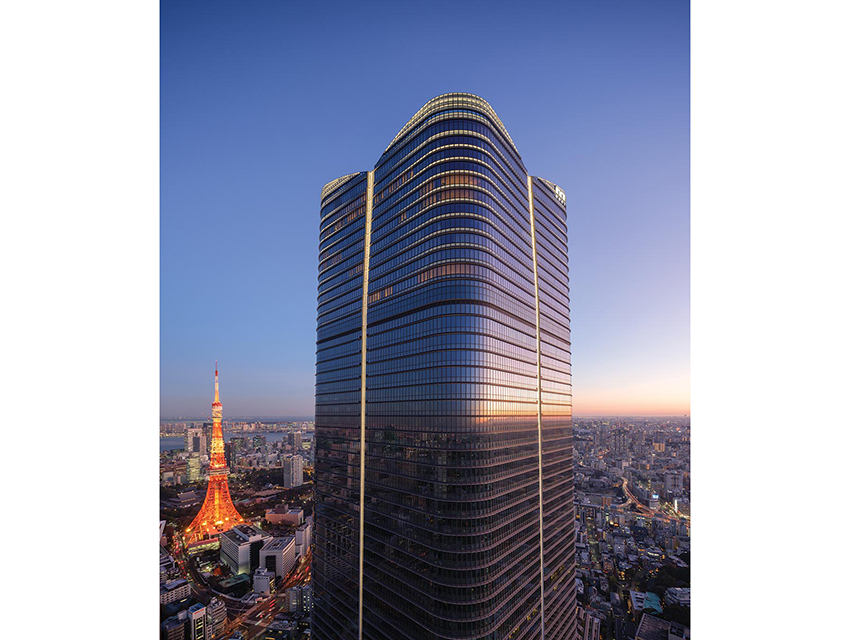
PHOTOGRAPHY: © JASON O’REAR
At the ground level, a louvered streetside plinth echoes the scale of the surrounding context. Uplights, integrated into every fifth fin, illuminate the undersides, while downlights wash other surfaces—a rounded-glass corner entrance filled with plants, or massive sloped columns near the office entrance—to dramatic effect.
“We see tall buildings as the intermediary between heaven and earth,” Clarke adds. “That’s what César Pelli always used to say.” Record-setting achievement notwithstanding, Mori JP Tower cuts an elegant, if still weighty, figure across the Tokyo skyline—day or night.
Hangzhou Century Center
SOM
TORYO International Lighting Design Center
BY MATTHEW MARANI
The city of Hangzhou, the capital of Zhejiang province, sits at the mouth of China’s Qiantang River, and, like other metropolises across the country, it has undergone exponential population growth over the last several decades, now at some 11 million residents. Having risen from approximately 600,000 in 1950, it developed along the way a panoply of skyscrapers, as well as a campus of parks and stadiums to support last year’s Asian Games. The Hangzhou Century Center, designed by SOM for developer Greenland Holdings, is one such project that—as a two-towered 1,000-foot-tall structure connected by a sweeping midsection—demands attention, especially with a spectacular lighting array that emblazons its sinuous form against the night sky.
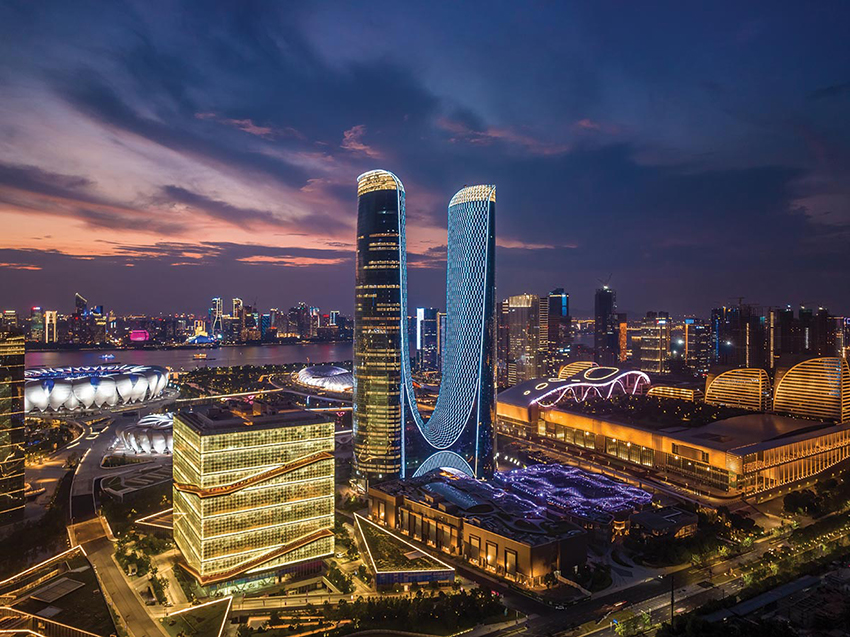
PHOTOGRAPHY: © HANGZHOU GREENLAND
The tower is a visual landmark for the urban district.
The Center, which contains offices, a hotel, and residences, is a linchpin for Qianjing Century City, a new nine-square-mile mixed-use district that incorporates the Asian Games sports infrastructure. Clad with a diaphanous glass veil that is suspended over the unitized glass curtain wall at the tower base and then merges into the fully enclosed facade as it arches upward, the supertall acts as a metaphorical and physical curtain opening to that urban scene. This outward-facing role is strengthened by the publicly accessible skybridge linking the two towers near their bases and by the more than 6,000 color-changing LEDs integrated into the glazing system on the internal face of the tower elevations.
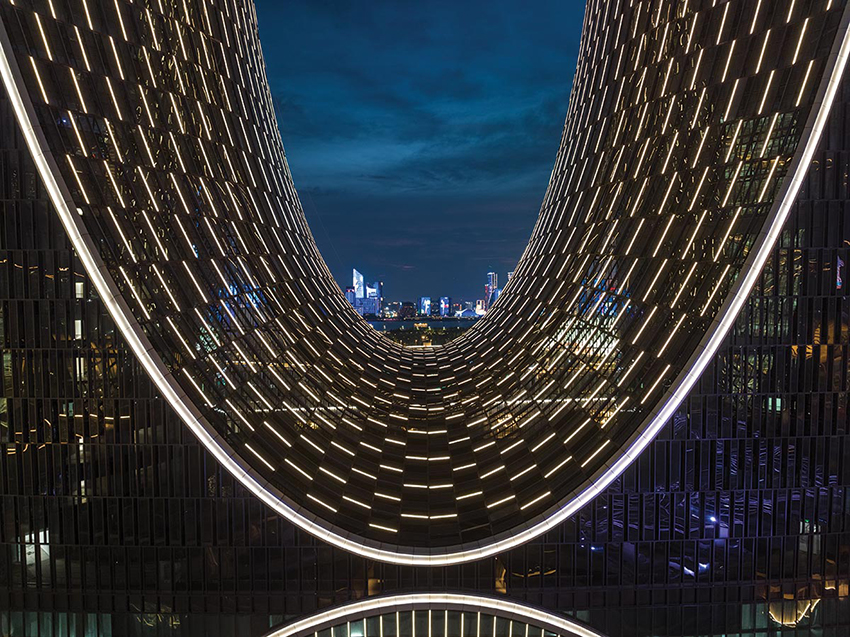
PHOTOGRAPHY: © HANGZHOU GREENLAND
The LEDs follow the tower form.
“Many of the most interesting buildings in the world can be encapsulated in two or three lines or movements. So, in this case, it is primarily those two curves,” says SOM associate director and design studio head Mark Nagis. “The idea behind the lighting was to do everything we could to reinforce those design aspects.”
That accomplishment was no small feat for a project of this scale. The glass overlay is fritted and arranged in a running-bond pattern; at the midsection, alternating modules remain open to the elements to act as both apertures and protective covers for the exterior space of the bridge below. The lighting scheme follows the building contours, being embedded within the curtain wall at the outward surface of each mullion, and runs vertically for some 15 miles across the facade. At the underside of the bridge, the design team opted for flat, triangular metal-panel cladding that follows the doubly curved surface; the gaps between those panels are fitted with additional LEDs. All the lights can be set to any color on the WRGB spectrum—literally millions of options—and they are currently programmed to change every minute, though that speed can be ramped up to 24 refreshes per second.
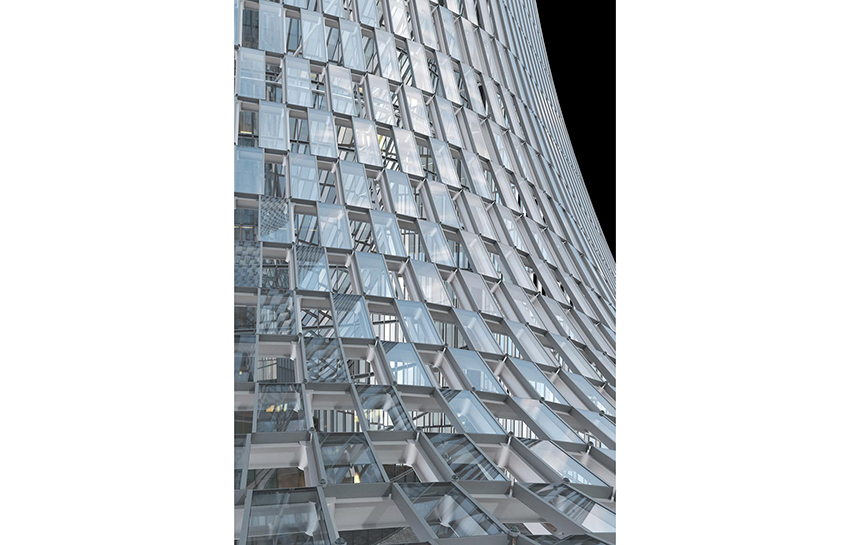
PHOTOGRAPHY: © HANGZHOU GREENLAND
The glazing is a screen for the bridge, then merges into the curtain wall.
SOM collaborated with Beijing-based lighting consultant TORYO International Lighting Design Center for the scheme and with Arup as the facade consultant. Both were critical in determining the feasibility of different design iterations, such as placing a field of individual LED dots at the intersections of spandrels and mullions. SOM’s in-house structural and mechanical engineers also helped guide decision-making. The sum of all those parts is an eye-catching edifice that successfully beckons residents and tourists to the banks of the Qiantang River and the heart of Hangzhou.
Credits
Architect: SOM
Architect of Record: Ecadi
Lighting Designer: TORYO International Design Center
Consultants: D+H (landscape); Arup (facade)
Client: Greenland Holdings
Size: 5.7 million square feet
Cost: withheld
Completion date: February 2023
Sources
Glazing: Taiwan Glass
Curtain Wall: YASHA
Lighting: Webb Deco (LED fixtures); CREE (LED chips)



